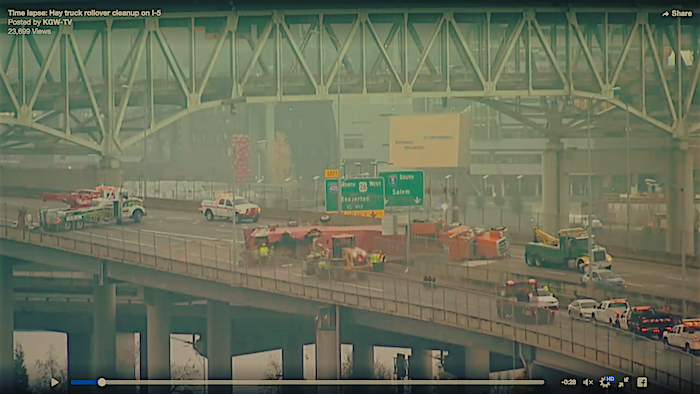Around 5 a.m. on Monday morning, a semi truck rollover crash blocked the northbound lanes of I-5 out of Portland.
Here’s an incredible view of the crash, captured by another vehicle on I-5 (or watch it on youtube here.)
Truck crashes happen all the time, but it’s not often that we get to see how it happens.
The anatomy of a semi truck rollover crash
This tractor-trailer was reportedly hauling about 90,000 lbs. of hay. That is a very heavy load, even for a commercial truck.
An Oregon Department of Transportation official said someone cut off the semi driver, who was traveling from Junction City, Oregon up to Tacoma, Washington.


Note that the interstate starts to curve at this point.
When a heavy truck moves along a curved path, centrifugal force causes it to lean away from the direction of the curve.

The tractor-trailer’s speed, heavy load, and high center of gravity result in a rollover.
The truck turned over, and then skidded to a halt.
Several Oregon news outlets reported that the driver was — thankfully—”not injured” or “not seriously injured.”
Due to the size of the load, and the location of the semi truck rollover crash on the Marquam Bridge, traffic was backed up for hours around Portland.

The 2003 Large Truck Crash Causation Study by the Federal Motor Carrier Safety Administration included an in-depth analysis of 239 crashes in which a truck rolled over.
About half were caused by “failing to adjust speed” to curves, ramps, the weight of the road, condition of the brakes, road surface and conditions.
Even when no one is injured, truck crashes can have serious repercussions.
This particular crash left drivers stuck in traffic for hours. It made thousands of commuters late for work, and required a huge cleanup by several public agencies.
Attorney Kevin Coluccio learned about the anatomy of a semi truck rollover in his 30+ years as an attorney for truck accident crash victims. He is also the author of a Legal Guide to a Truck Crash Lawsuit.
You can reach Coluccio here.




